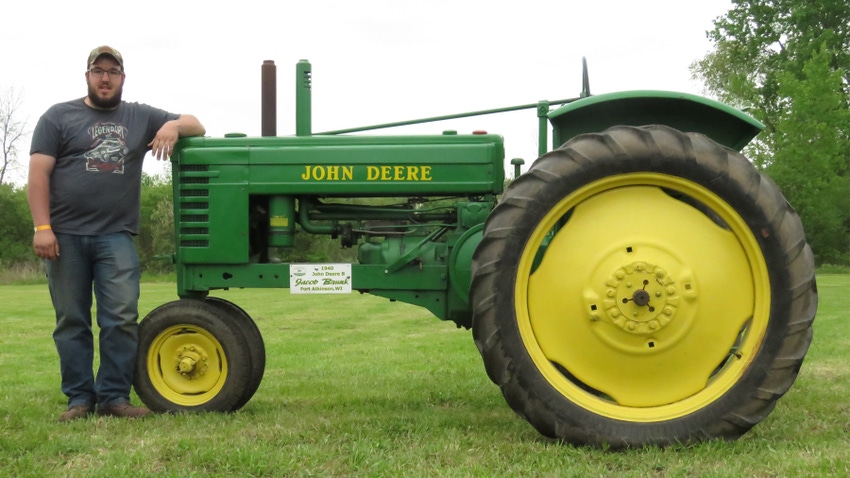June 23, 2023

Jacob Brunk became the owner of his favorite tractor, a 1940 Model B John Deere, serial number 88554, in 2013 when he purchased the machine for $2,300 at an auction in Wautoma, Wis. Brunk, from Sun Prairie, Wis., believes he is the second or third owner. The tractor was manufactured in Waterloo, Iowa, and shipped to a Milwaukee warehouse. Later, the new tractor went to Westfield Produce Co. in Marquette County, Wis. In 1941, it was sold to a dairy farmer, Alden Tonn.
“The B was restored but still had the original turkey track tires. It was fairly tough to plow with them because the tread pattern had a poor grip,” Brunk says. “I replaced the front assembly steering gear, changed the oil and did other routine maintenance chores.”
This machine was a two-plow row crop tractor produced from 1939 to 1952, with direct successions produced until 1960. The B was a scaled-down, less-expensive version of the John Deere Model A. It was followed by the updated 50, 520 and 530 models. In June 1938, production began on the new “styled” B for the 1939 model year. The upgraded B featured a larger engine and sheet metal tricycle front axle. The horsepower rating was 18 on the drawbar and 20.5 on the belt, with enough capacity to operate a 2-foot, 14-inch plow. There were 109,253 units made, and the original price in 1952 was $1,900.
Other features included manual steering; open-cab operator station with a pressed steel seat; hand-cranked starter (electric optional); dry disc clutch; four forward gears and one reverse gear; 12-gallon-capacity fuel tank; differential mechanical expanding shoe brakes; 4-by-2, two-wheel-drive chassis; Powr-Trol hydraulics; power lift hitch; top road speed of 18 mph; a weight between 2,898 and 3,800 pounds; and a John Deere 2.9-liter, two-cylinder, all-fuel, liquid-cooled engine.
Show tractor
Today, the tractor goes to many shows around Wisconsin during the summer, including Baraboo Badger Steam and Gas, Rumley Acres in Cleveland, Tri County Threshers in Plainfield, Rock River Threshers in Edgerton, and Dodge County Power Show, as well as Farm Heritage Days in Greenville, Ill. At these events, it is used to operate belt power jobs such as a shingle mill, move other pieces of equipment, and put on the Baker fan to adjust carburetor and tune motors.
Brunk, a mechanic at Lincoln Contractors Supply in McFarland, Wis., has four other tractors in his collection — a 1935 John Deere A, a 1929 Farmall F-20, a 1942 John Deere AR with a wide front end, and another B, a 1936 model.
“My tractor collection is strictly a hobby, enjoyable and an opportunity to relive the heritage for an earlier era of agriculture,” Brunk says. “The B is my favorite because I drove that model when I was 8 years old at my cousin John Wolff’s place in Lake Mills. It starts so easily, is reliable, and my sons — Karson, 9, Landon, 4, and Corbin, 1 — are always in line to take it for a spin.”
Persinger writes from Milwaukee. To have your favorite tractor featured, email or send in a photo of yourself with your tractor, along with a 300-word write-up about the tractor, to: [email protected] or Wisconsin Agriculturist, P.O. Box 236, Brandon, WI 53919.
Read more about:
TractorsAbout the Author(s)
You May Also Like




